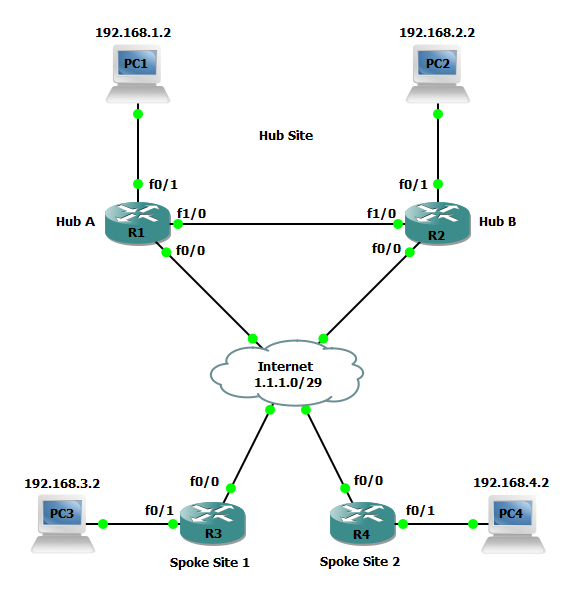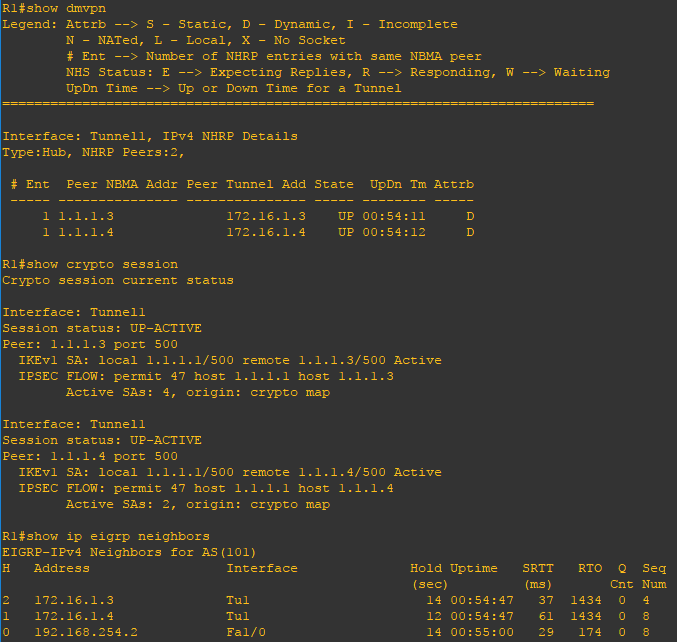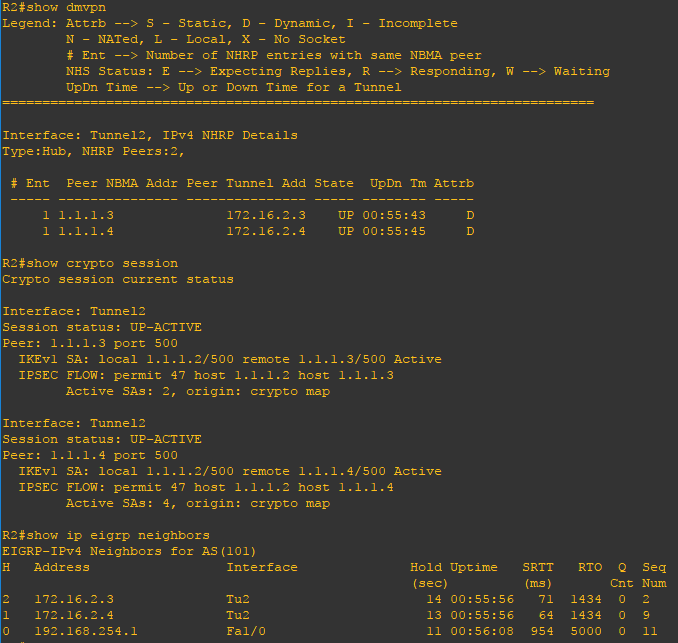What is a Dynamic Multipoint VPN and why to use it?
DMVPN provides the capability for creating a dynamic-mesh VPN network without having to pre-configure (static) all possible tunnel end-point peers, including IPsec (Internet Protocol Security) and ISAKMP (Internet Security Association and Key Management Protocol) peers. DMVPN is initially configured to build out a hub-and-spoke network by statically configuring the hubs (VPN headends) on the spokes, no change in the configuration on the hub is required to accept new spokes. Using this initial hub-and-spoke network, tunnels between spokes can be dynamically built on demand (dynamic-mesh) without additional configuration on the hubs or spokes. This dynamic-mesh capability alleviates the need for any load on the hub to route data between the spoke networks..
In the example below we will build two hub routers in the hub site for redundancy and two spoke sites. Users sitting behind these routers must be able to reach other site and any new networks provisioned in either site should be advertised to the router is the opposite site automatically. Spoke site should learn routes and advertise the local routes to the hub sites but other spoke sites should not learn routes for other spoke sites. Users in either location must only be allowed to access the site using approved protocols such as FTP, HTTP, DNS, etc. Lastly, each router must be configured for a firewall to protect the device and users from Internet attack without impeding the ability to establish a site-to-site VPN.

Steps to configure DMVPN on hub routers
Step 1: Perform a basic router configuration on R1 and R2 to establish connectivity. Notice the NAT access-list 101 include a deny clause to prevent the remote VPN traffic from using NAT.
R1(config)#interface FastEthernet0/0 R1(config-if)#ip address 1.1.1.1 255.255.255.248 R1(config-if)#ip nat outside ! R1(config)#interface FastEthernet0/1 R1(config-if)#ip address 192.168.1.1 255.255.255.0 R1(config-if)#ip nat inside ! R1(config)#interface FastEthernet1/0 R1(config-if)#ip address 192.168.254.1 255.255.255.0 R1(config-if)#ip nat inside ! R1(config)#ip nat inside source list 101 interface FastEthernet0/0 overload ! R1(config)#access-list 101 deny ip 192.168.0.0 0.0.255.255 192.168.0.0 0.0.255.255 R1(config)#access-list 101 permit ip 192.168.0.0 0.0.255.255 any
R2(config)#interface FastEthernet0/0 R2(config-if)#ip address 1.1.1.2 255.255.255.248 R2(config-if)#ip nat outside ! R2(config)#interface FastEthernet0/1 R2(config-if)#ip address 192.168.2.1 255.255.255.0 R2(config-if)#ip nat inside ! R2(config)#interface FastEthernet1/0 R2(config-if)#ip address 192.168.254.2 255.255.255.0 R2(config-if)#ip nat inside ! R2(config)#ip nat inside source list 101 interface FastEthernet0/0 overload ! R2(config)#access-list 101 deny ip 192.168.0.0 0.0.255.255 192.168.0.0 0.0.255.255 R2(config)#access-list 101 permit ip 192.168.0.0 0.0.255.255 any
Step 2: Configure a crypto isakmp policy and set the crypto isakmp pre-share key on R1 and R2.
R1(config-if)#crypto isakmp policy 1 R1(config-isakmp)#encryption 3des R1(config-isakmp)#authentication pre-share R1(config-isakmp)#group 2 ! R1(config)#crypto isakmp key vpnpasswordhere address 0.0.0.0
R2(config)#crypto isakmp policy 1 R2(config-isakmp)#encryption 3des R2(config-isakmp)#authentication pre-share R2(config-isakmp)#group 2 ! R2(config)#crypto isakmp key vpnpasswordhere address 0.0.0.0
Step 3: Configure a crypto ipsec transform-set, crypto ipsec profile, and tunnel interface on R1 and R2.
R1(config)#crypto ipsec transform-set TS-DMVPN-VPN esp-aes esp-sha-hmac ! R1(config)#crypto ipsec profile DMVPN-VPN R1(ipsec-profile)#set security-association lifetime seconds 86400 R1(ipsec-profile)#set transform-set TS-DMVPN-VPN ! R1(config)#interface Tunnel1 R1(config-if)#ip address 172.16.1.1 255.255.255.0 R1(config-if)#ip nhrp authentication dmsvpnpassword1 R1(config-if)#no ip redirects R1(config-if)#ip nhrp authentication firewall R1(config-if)#ip nhrp map multicast dynamic R1(config-if)#ip nhrp network-id 1 R1(config-if)#tunnel source 1.1.1.1 R1(config-if)#tunnel mode gre multipoint R1(config-if)#tunnel key 1 R1(config-if)#tunnel protection ipsec profile DMVPN-VPN
R2(config)#crypto ipsec transform-set TS-DMVPN-VPN esp-aes esp-sha-hmac ! R2(config)#crypto ipsec profile DMVPN-VPN R2(ipsec-profile)#set security-association lifetime seconds 86400 R2(ipsec-profile)#set transform-set TS-DMVPN-VPN ! R2(config)#interface Tunnel2 R2(config-if)#ip address 172.16.2.2 255.255.255.0 R2(config-if)#ip nhrp authentication dmsvpnpassword2 R2(config-if)#no ip redirects R2(config-if)#ip nhrp authentication firewall R2(config-if)#ip nhrp map multicast dynamic R2(config-if)#ip nhrp network-id 2 R2(config-if)#tunnel source 1.1.1.2 R2(config-if)#tunnel mode gre multipoint R2(config-if)#tunnel key 2 R2(config-if)#tunnel protection ipsec profile DMVPN-VPN
Step 4: Configure a EIGRP routing process on each router advertising local networks and tunnel networks.
R1(config)#router eigrp 101 R1(config-router)#network 192.168.1.0 0.0.0.255 R1(config-router)#network 192.168.254.0 0.0.0.3 R1(config-router)#network 172.16.1.0 0.0.0.255
R2(config)#router eigrp 101 R2(config-router)#network 192.168.2.0 0.0.0.255 R2(config-router)#network 192.168.254.0 0.0.0.3 R2(config-router)#network 172.16.2.0 0.0.0.255
Steps to configure DMVPN on spoke routers
Step 5: Perform a basic router configuration on R3 and R4 to establish connectivity. Notice the NAT access-list 101 include a deny clause to prevent the remote VPN traffic from using NAT.
R3(config)#interface FastEthernet0/0 R3(config-if)#ip address 1.1.1.3 255.255.255.248 R3(config-if)#ip nat outside ! R3(config)#interface FastEthernet0/1 R3(config-if)#ip address 192.168.3.1 255.255.255.0 R3(config-if)#ip nat inside ! R3(config)#ip nat inside source list 101 interface FastEthernet0/0 overload ! R3(config)#access-list 101 deny ip 192.168.0.0 0.0.255.255 192.168.0.0 0.0.255.255 R3(config)#access-list 101 permit ip 192.168.0.0 0.0.255.255 any
R4(config)#interface FastEthernet0/0 R4(config-if)#ip address 1.1.1.4 255.255.255.248 R4(config-if)#ip nat outside ! R4(config)#interface FastEthernet0/1 R4(config-if)#ip address 192.168.4.1 255.255.255.0 R4(config-if)#ip nat inside R4(config)#ip nat inside source list 101 interface FastEthernet0/0 overload ! R4(config)#access-list 101 deny ip 192.168.0.0 0.0.255.255 192.168.0.0 0.0.255.255 R4(config)#access-list 101 permit ip 192.168.0.0 0.0.255.255 any
Step 6: Configure a crypto isakmp policy and set the crypto isakmp pre-share key on R3 and R4.
R3(config)#crypto isakmp policy 1 R3(config-isakmp)#encryption 3des R3(config-isakmp)#authentication pre-share R3(config-isakmp)#group 2 ! R3(config)#crypto isakmp key vpnpasswordhere address 0.0.0.0 0.0.0.0
R4(config)#crypto isakmp policy 1 R4(config-isakmp)#encryption 3des R4(config-isakmp)#authentication pre-share R4(config-isakmp)#group 2 ! R4(config)#crypto isakmp key vpnpasswordhere address 0.0.0.0 0.0.0.0
Step 7: Configure a crypto ipsec transform-set, crypto ipsec profile, and tunnel interfaces on R3 and R4.
R3(config)#crypto ipsec transform-set TS-DMVPN-VPN esp-aes esp-sha-hmac ! R3(config)#crypto ipsec profile DMVPN-VPN R3(ipsec-profile)#set security-association lifetime seconds 86400 R3(ipsec-profile)#set transform-set TS-DMVPN-VPN ! R3(config)#interface Tunnel1 R3(config-if)#ip address 172.16.1.3 255.255.255.0 R3(config-if)#ip nhrp authentication dmsvpnpassword1 R3(config-if)#no ip redirects R3(config-if)#ip nhrp authentication firewall R3(config-if)#ip nhrp map multicast dynamic R3(config-if)#ip nhrp map 172.16.0.1 1.1.1.1 R3(config-if)#ip nhrp map multicast 1.1.1.1 R3(config-if)#ip nhrp network-id 1 R3(config-if)#ip nhrp nhs 172.16.0.1 R3(config-if)#tunnel source FastEthernet0/0 R3(config-if)#tunnel mode gre multipoint R3(config-if)#tunnel key 1 R3(config-if)#tunnel protection ipsec profile DMVPN-VPN shared ! R3(config)#interface Tunnel2 R3(config-if)#ip address 172.16.2.3 255.255.255.0 R3(config-if)#ip nhrp authentication dmsvpnpassword2 R3(config-if)#no ip redirects R3(config-if)#ip nhrp authentication firewall R3(config-if)#ip nhrp map multicast dynamic R3(config-if)#ip nhrp map 172.16.0.2 1.1.1.2 R3(config-if)#ip nhrp map multicast 1.1.1.2 R3(config-if)#ip nhrp network-id 2 R3(config-if)#ip nhrp nhs 172.16.0.2 R3(config-if)#tunnel source FastEthernet0/0 R3(config-if)#tunnel mode gre multipoint R3(config-if)#tunnel key 2 R3(config-if)#tunnel protection ipsec profile DMVPN-VPN shared
R4(config)#crypto ipsec transform-set TS-DMVPN-VPN esp-aes esp-sha-hmac ! R4(config)#crypto ipsec profile DMVPN-VPN R4(ipsec-profile)#set security-association lifetime seconds 86400 R4(ipsec-profile)#set transform-set TS-DMVPN-VPN ! R4(config)#interface Tunnel1 R4(config-if)#ip address 172.16.1.4 255.255.255.0 R4(config-if)#ip nhrp authentication dmsvpnpassword1 R4(config-if)#no ip redirects R4(config-if)#ip nhrp authentication firewall R4(config-if)#ip nhrp map multicast dynamic R4(config-if)#ip nhrp map 172.16.0.1 1.1.1.1 R4(config-if)#ip nhrp map multicast 1.1.1.1 R4(config-if)#ip nhrp network-id 1 R4(config-if)#ip nhrp nhs 172.16.0.1 R4(config-if)#tunnel source FastEthernet0/0 R4(config-if)#tunnel mode gre multipoint R4(config-if)#tunnel key 1 R4(config-if)#tunnel protection ipsec profile DMVPN-VPN shared ! R4(config)#interface Tunnel2 R4(config-if)#ip address 172.16.2.4 255.255.255.0 R4(config-if)#ip nhrp authentication dmsvpnpassword1 R4(config-if)#no ip redirects R4(config-if)#ip nhrp authentication firewall R4(config-if)#ip nhrp map multicast dynamic R4(config-if)#ip nhrp map 172.16.0.2 1.1.1.2 R4(config-if)#ip nhrp map multicast 1.1.1.2 R4(config-if)#ip nhrp network-id 2 R4(config-if)#ip nhrp nhs 172.16.0.2 R4(config-if)#tunnel source FastEthernet0/0 R4(config-if)#tunnel mode gre multipoint R4(config-if)#tunnel key 2 R4(config-if)#tunnel protection ipsec profile DMVPN-VPN shared
Step 8: Configure a EIGRP routing process on each router advertising local networks and tunnel networks.
R3(config)#router eigrp 101 R3(config-router)#eigrp stub R3(config-router)#network 192.168.3.0 0.0.0.255 R3(config-router)#network 172.16.1.0 0.0.0.255 R3(config-router)#network 172.16.2.0 0.0.0.255
R4(config-if)#router eigrp 101 R4(config-router)#eigrp stub R4(config-router)#network 192.168.4.0 0.0.0.255 R4(config-router)#network 172.16.1.0 0.0.0.255 R4(config-router)#network 172.16.2.0 0.0.0.255
Configure a Zone-Based Firewall on DMVPN routers
Step 9: Configure the applicable security zones and assign them to Interfaces including tunnel interfaces.
R1(config)#zone security INTERNET ! R1(config-sec-zone)#zone security LAN ! R1(config)#zone security S2SVPN ! R1(config-sec-zone)#interface Tunnel1 R1(config-if)# zone-member security S2SVPN ! R1(config)#interface FastEthernet0/0 R1(config-if)# zone-member security INTERNET ! R1(config)#interface FastEthernet0/1 R1(config-if)# zone-member security LAN
R2(config)#zone security INTERNET ! R2(config-sec-zone)#zone security LAN ! R1(config)#zone security S2SVPN ! R2(config-sec-zone)#interface Tunnel2 R2(config-if)# zone-member security S2SVPN ! R2(config)#interface FastEthernet0/0 R2(config-if)# zone-member security INTERNET ! R2(config)#interface FastEthernet0/1 R2(config-if)# zone-member security LAN
Step 10: Create a class-map, policy-map, and zone-pair to allow traffic from the local LAN to the Internet.
R1(config)#class-map type inspect match-any LAN-ALLOWED-PROTOCOLS R1(config-cmap)#match protocol icmp R1(config-cmap)#match protocol dns R1(config-cmap)#match protocol ftp R1(config-cmap)#match protocol https R1(config-cmap)#match protocol http R1(config-cmap)#match protocol tcp R1(config-cmap)#match protocol udp ! R1(config)#policy-map type inspect LAN-TO-INTERNET-POLICY R1(config-pmap)#class type inspect LAN-ALLOWED-PROTOCOLS R1(config-pmap-c)#inspect R1(config-pmap)#class class-default R1(config-pmap-c)#drop ! R1(config)#zone-pair security ZP-LAN-TO-INTERNET source LAN destination INTERNET R1(config-sec-zone-pair)# service-policy type inspect LAN-TO-INTERNET-POLICY
R1(config)#class-map type inspect match-any LAN-ALLOWED-PROTOCOLS R2(config-cmap)#match protocol icmp R2(config-cmap)#match protocol dns R2(config-cmap)#match protocol ftp R2(config-cmap)#match protocol https R2(config-cmap)#match protocol http R2(config-cmap)#match protocol tcp R2(config-cmap)#match protocol udp ! R2(config)#policy-map type inspect LAN-TO-INTERNET-POLICY R2(config-pmap)#class type inspect LAN-ALLOWED-PROTOCOLS R2(config-pmap-c)#inspect R2(config-pmap)#class class-default R2(config-pmap-c)#drop ! R2(config)#zone-pair security ZP-LAN-TO-INTERNET source LAN destination INTERNET R2(config-sec-zone-pair)# service-policy type inspect LAN-TO-INTERNET-POLICY
Step 11: Create two access-list, a class-map, policy-map, and zone-pair to allow traffic from the remote VPN router over the Internet into the self zone to establish the site-to-site VPN.
R1(config)#ip access-list extended ICMP R1(config-ext-nacl)#permit icmp any any echo R1(config-ext-nacl)#permit icmp any any echo-reply R1(config-ext-nacl)#permit icmp any any traceroute ! R1(config)#ip access-list extended ISAKMP_IPSEC R1(config-ext-nacl)#permit udp any any eq isakmp R1(config-ext-nacl)#permit ahp any any R1(config-ext-nacl)#permit esp any any R1(config-ext-nacl)#permit udp any any eq non500-isakmp ! R1(config)#class-map type inspect match-all ICMP-POLICY R1(config-cmap)#match access-group name ICMP ! R1(config)#class-map type inspect match-all IPSEC-POLICY R1(config-cmap)#match access-group name ISAKMP_IPSEC ! R1(config)#policy-map type inspect INTERNET-TO-SELF-POLICY R1(config-pmap)#class type inspect ICMP-POLICY R1(config-pmap-c)#inspect R1(config-pmap)#class type inspect IPSEC-POLICY R1(config-pmap-c)#pass R1(config-pmap)#class class-default R1(config-pmap-c)#drop ! R1(config)#zone-pair security ZP-INTERNET-TO-SELF source INTERNET destination self R1(config-sec-zone-pair)#service-policy type inspect INTERNET-TO-SELF-POLICY
R2(config)#ip access-list extended ICMP R2(config-ext-nacl)#permit icmp any any echo R2(config-ext-nacl)#permit icmp any any echo-reply R2(config-ext-nacl)#permit icmp any any traceroute ! R2(config)#ip access-list extended ISAKMP_IPSEC R2(config-ext-nacl)#permit udp any any eq isakmp R2(config-ext-nacl)#permit ahp any any R2(config-ext-nacl)#permit esp any any R2(config-ext-nacl)#permit udp any any eq non500-isakmp ! R2(config)#class-map type inspect match-all ICMP-POLICY R2(config-cmap)#match access-group name ICMP ! R2(config)#class-map type inspect match-all IPSEC-POLICY R2(config-cmap)#match access-group name ISAKMP_IPSEC ! R2(config)#policy-map type inspect INTERNET-TO-SELF-POLICY R2(config-pmap)#class type inspect ICMP-POLICY R2(config-pmap-c)#inspect R2(config-pmap)#class type inspect IPSEC-POLICY R2(config-pmap-c)#pass R2(config-pmap)#class class-default R2(config-pmap-c)#drop ! R2(config)#zone-pair security ZP-INTERNET-TO-SELF source INTERNET destination self R2(config-sec-zone-pair)#service-policy type inspect INTERNET-TO-SELF-POLICY
Step 12: Configure a policy-map and zone-pair to allow traffic from the local LAN to the site-to-site VPN. We will make use of the preexisting class-map called LAN-ALLOWED-PROTOCOLS.
R1(config)#policy-map type inspect S2SVPN-POLICY R1(config-pmap)#class type inspect LAN-ALLOWED-PROTOCOLS R1(config-pmap-c)#inspect R1(config-pmap)#class class-default R1(config-pmap-c)#drop ! R1(config)#zone-pair security ZP-LAN-TO-S2SVPN source LAN destination S2SVPN R1(config-sec-zone-pair)#service-policy type inspect S2SVPN-POLICY
R2(config)#policy-map type inspect S2SVPN-POLICY R2(config-pmap)#class type inspect LAN-ALLOWED-PROTOCOLS R2(config-pmap-c)#inspect R2(config-pmap)#class class-default R2(config-pmap-c)#drop ! R2(config)#zone-pair security ZP-LAN-TO-S2SVPN source LAN destination S2SVPN R2(config-sec-zone-pair)#service-policy type inspect S2SVPN-POLICY
Step 13: Configure a zone-pair to allow traffic from the site-to-site VPN to local LAN. We will make sure of the preexisting policy-map S2SVPN-POLICY and class-map LAN-ALLOWED-PROTOCOLS.
R1(config)#zone-pair security ZP-S2SVPN-TO-LAN source S2SVPN destination LAN R1(config-sec-zone-pair)#service-policy type inspect S2SVPN-POLICY
R2(config)#zone-pair security ZP-S2SVPN-TO-LAN source S2SVPN destination LAN R2(config-sec-zone-pair)#service-policy type inspect S2SVPN-POLICY
Step 14: Repeat the exact same configurations for the spoke routers R3 and R4 with the only change being you will need to assign two tunnels to the S2SVPN zone.
R3(config-sec-zone)#interface Tunnel1 R3(config-if)# zone-member security S2SVPN ! R3(config-sec-zone)#interface Tunnel2 R3(config-if)# zone-member security S2SVPN
R4(config-sec-zone)#interface Tunnel1 R4(config-if)# zone-member security S2SVPN ! R4(config-sec-zone)#interface Tunnel2 R4(config-if)# zone-member security S2SVPN
Verify the configuration
Now that the configuration is finished lets verify the configuration. Using the show dmvpn, show crypto engine connection active, show crypto session, show crypto isakmp sa, and show crypto ipsec sa commands you can verify the VPN deployment. You can also use the show ip route and show ip eigrp neighbors command to verify dynamic routing is properly working. Lastly, use the ping command to verify connectivity.


